EARLY BROADCASTING
INTHE
SAN FRANCISCO
BAY AREA
STATIONS THAT DIDN'T SURVIVE: 1920-25
Copyright 1997, John F. Schneider
Seattle, Washington
Radio broadcasting as an experimental concept had an early start in the San Francisco Bay area with the activities of Doc Herrold in San Jose. Herrold's station which started broadcasting on a regular basis in 1912. This pioneer station eventually became KQW and later KCBS.
Apart from Doc Herrold and a few other pioneer efforts, however, regular broadcasting to the public did not commence until 1920. That was the year that some of the first serious broadcast stations appeared in different parts of the country, including KDKA in Pittsburgh, Pennsylvania. There was a gradual growth in the public’s interest in radio for the next two years, and then suddenly an explosion of interest in 1922. In that year, the number of radio broadcasters in the country grew from a few dozen to more than 450. The explosive and sudden growth of radio in 1922 has parallels today in the sudden growth of the internet beginning about 1995.
In that early gestation period between 1920 and 1922, San Francisco led the country in the number of broadcast stations. At a time when most major cities in the U.S. had only one or two radio stations, the San Francisco area had seven: 6XC (KZY), 6XG (KDN), 6XAJ (KZM), 6XAC (KLP), 6XAG (KJJ), 6XAM (KLS), and AG1.
However, it’s hard to pin down the number of stations precisely, because that number was constantly changing, due to the fledgling nature of the field. Small stations would come on the air for several months, operated on a shoestring budget by young experimenters and then would suddenly go off the air, to be replaced as quickly by other short- lived stations. These radio stations stood with a foot in the new world of broadcasting and another foot entrenched in the world of amateur radio. The purpose of the station was often experimental, or to promote the activities of the business that operated it. The advertising revenue that provided stability for radio in its later years had yet to develop, and so there was no income to financially sustain the stations' activities. (The first recognized on-air advertisement took place on WBAY in New York on August 28, 1922). Equipment failures were frequent, and the programming itself was of secondary importance - what was important was just being on the air.
At first, radio broadcasting stations operated with an experimental amateur license, and with call signs such as 6XAJ. They could operate over a wide range of frequencies. However, new Department of Commerce regulations went into effect on December 1, 1921, which required all non-government broadcasting stations to obtain a “Limited Commercial” license. These new licenses came with new three- or four-letter call signs; thus 6XAJ became KZM. This new license also required all stations to broadcast on the single authorized frequency of 360 meters (833 kHz). Because the stations could not operate simultaneously on this channel without causing interference to each other, the owners of the stations met and agreed upon a time-sharing schedule. Each station would have exclusive use of the frequency for several hours each day. (The F.R.C. finally ended the sharing of this one frequency and assigned stations individual frequencies on May 15, 1923.)
To a listener of that time, radio was a new discovery. Again, programs didn't matter. It was the sheer enjoyment of listening to voices and music being pulled out of the air with a home-built crystal set. Within the course of two years, radio went from a means of point-to-point communications for commercial purposes, plus the activities of a small group of radio "hams", to everybody's hobby, and wire antennas stretched across the back yards of more and more households. Young boys found radio particularly exciting, and children across the country were winding wire around oatmeal boxes to build their own crystal radios. The "San Francisco Examiner" noted the sudden rise in radio's popularity when it reported in 1922, "Radio, the virulent malady which has swept the East, is rapidly spreading to the coast. Once bitten by the germ, there is no cure for the delighted victim."
Radio programs during this period consisted almost entirely of phonograph records, with only occasional news reports, crop reports or live music programs. Programs did not have the polished, produced sound of later years. For example, KUO, the "Examiner" station, announced its programs, "Hello; hello; this is the San Francisco Examiner's radio broadcasting station, KUO -- K - U - O. Receivers will kindly give us a check. Thank you, thank you."
6UV/KYY
Perhaps the first station to broadcast in the San Francisco area after Doc Herrold's KQW, was 6UV, a tiny station operated by the Radio Telephone Shop at 175 Steuart Street, near the San Francisco waterfront. That section of Steuart Street was known as "radio row", because of the large number of radio parts stores located there. 6UV, later re-licensed KYY, was operated by the store's proprietor, A. F. Pendleton. He was on the air from 8 to 9 PM every Tuesday and Friday night on 425 meters. 6UV first went on the air about March or April, 1920, and operated only for about two years.
6XW/AG1
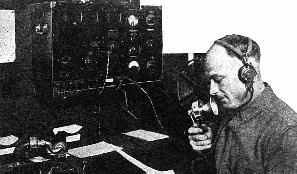 Another of the early broadcast operations was carried on by the U. S. Army. The
Army Signal Corps at the Presidio Army base operated an amateur station to
communicate with local amateurs and other Army bases, but it also broadcast
music and information programs to the general public. Known first as 6XW and
then later by the call letters AG1, this station was operated by Sgt. Richard C.
Travers. In an article appearing in 1921 in "Radio" Magazine, Sgt.
Travers described the purpose of the operation:
Another of the early broadcast operations was carried on by the U. S. Army. The
Army Signal Corps at the Presidio Army base operated an amateur station to
communicate with local amateurs and other Army bases, but it also broadcast
music and information programs to the general public. Known first as 6XW and
then later by the call letters AG1, this station was operated by Sgt. Richard C.
Travers. In an article appearing in 1921 in "Radio" Magazine, Sgt.
Travers described the purpose of the operation:
The experimental work of the Signal Corps School, Presidio of San Francisco, California, was commenced about August 1, 1920, with the idea in view of determining the maximum efficiency of some Signal Corps equipment ... Another reason was to afford a means of educating new amateurs just coming into the game and at the same time advocate the C. W. transmission for the amateur with a view of lessening interference. Considerable has been accomplished up to the present in both undertakings. In a recent test made by the school, it was shown that there are 320 that are actually interested in the educational matters and concerts transmitted by this station. And, from the same test report it was shown than an audience of about 5,000 people listen to the radiophone concerts.AG1 broadcast a concert of phonograph records every Sunday evening from 7 to 9 PM, and during this program Sgt. Travers answered questions put to him by his listeners. The Presidio continued its broadcast activities until mid-1923.
6XC/KZY
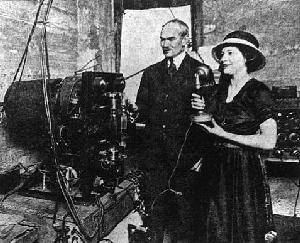 One of the most prominent early stations in the San Francisco area was 6XC,
operated by the renowned radio inventory Lee DeForest. DeForest
had been operating a pioneer experimental broadcast station in New York, known
as 2XG. However, the radio
inspector there shut the station down due to a technical infraction. So DeForest had the transmitter shipped to San Francisco, and
it returned to the air in April of 1920 as 6XC. DeForest installed his thousand watt transmitter at the
California Theater, Fourth and Market Streets, and strung an antenna to a mast
on top of the nearby Humboldt Bank Building. The equipment was located in a
small concrete room in the "fly galleries". The station broadcast
music by the theater organ, and by Hermann Heller's Symphony Orchestra live from
the stage., DeForest installed receivers in several area hospitals to pick up
the concerts.
One of the most prominent early stations in the San Francisco area was 6XC,
operated by the renowned radio inventory Lee DeForest. DeForest
had been operating a pioneer experimental broadcast station in New York, known
as 2XG. However, the radio
inspector there shut the station down due to a technical infraction. So DeForest had the transmitter shipped to San Francisco, and
it returned to the air in April of 1920 as 6XC. DeForest installed his thousand watt transmitter at the
California Theater, Fourth and Market Streets, and strung an antenna to a mast
on top of the nearby Humboldt Bank Building. The equipment was located in a
small concrete room in the "fly galleries". The station broadcast
music by the theater organ, and by Hermann Heller's Symphony Orchestra live from
the stage., DeForest installed receivers in several area hospitals to pick up
the concerts.
The most prominent recollection of those who remember tuning in to 6XC is that it broadcast on an extremely low frequency. Early broadcasts were on 1450 meters, but this was soon changed to 1260 meters (238 kHz).
DeForest employed a full-time station operator to broadcast the concerts, Charles Logwood, who had been an assistant to the early San Francisco radio experimenter Francis McCarty in 1905. Logwood operated the transmitter and audio equipment during the frequent concerts. Weekdays there would be three half-hour concerts per day, plus the Heller Orchestra concerts every Sunday morning. To pick up the music of the orchestra, a microphone was attached to the end of a large loudspeaker horn, and the entire assembly was hung from the ceiling in the back of the theater.
This station was notable for many reasons, in addition to the fact that it was established by DeForest. 6XC was in daily operation over six months prior to KDKA in Pittsburgh, and it broadcast regularly scheduled programs composed entirely of live music at a time when the few "radio concerts" on the air consisted entirely of phonograph records. In addition, while most broadcast transmitters of the time operated at between five and fifty watts, DeForest had installed a thousand watt transmitter, though it seldom operated above half its capacity.
6XC broadcast over 1,500 daily programs from the California Theater between April, 1920, and December, 1921, at which time the new regulations went into effect requiring it to obtain a Limited Commercial License. At that time, the station was transferred from Lee DeForest, Incorporated, to the the Atlantic-Pacific Radio Corporation, which was the Western representative for the DeForest Radio Telephone and Telegraph Company. The new license required a modification of the transmitter to allow operation on the new broadcast frequency of 360 meters. The transmitter was moved to the home of Henry M. Shaw, President of the company, located on Ocean View Drive in the Rock Ridge area of Oakland. With its new license in hand, the station became KZY, "The Rock Ridge Station", operated by the Atlantic-Pacific Company.
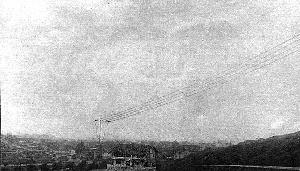 The
installation of the station in Oakland was completed in record time. Shaw
desired to have the station on the air Christmas Day, and this gave the crew
just over a week to complete the installation. The antenna was to be 135 feet
long, suspended between two tall masts. However, Shaw's property was not big
enough to accommodate both masts, so it was decided to put the other on a
neighbor's property, directly up the hill. This property, it was found, was
owned by a Santa Barbara man. Telegrams
to Santa Barbara determined that the owner was on vacation and could not be
reached. In desperation, Shaw sent Fred Anderson to Santa Barbara, where he
learned the owner was vacationing in Los Angeles. Anderson drove on to Los
Angeles the same day, found the man and had him sign an agreement for the use of
the property. He returned December 18th and construction was begun the same day.
The first test transmissions were made just four days later, and the station
went on the air at midnight, Christmas Day, 1921. The initial program consisted
of several hours of Christmas carols, and closed with an official announcement
of the opening of the station.
The
installation of the station in Oakland was completed in record time. Shaw
desired to have the station on the air Christmas Day, and this gave the crew
just over a week to complete the installation. The antenna was to be 135 feet
long, suspended between two tall masts. However, Shaw's property was not big
enough to accommodate both masts, so it was decided to put the other on a
neighbor's property, directly up the hill. This property, it was found, was
owned by a Santa Barbara man. Telegrams
to Santa Barbara determined that the owner was on vacation and could not be
reached. In desperation, Shaw sent Fred Anderson to Santa Barbara, where he
learned the owner was vacationing in Los Angeles. Anderson drove on to Los
Angeles the same day, found the man and had him sign an agreement for the use of
the property. He returned December 18th and construction was begun the same day.
The first test transmissions were made just four days later, and the station
went on the air at midnight, Christmas Day, 1921. The initial program consisted
of several hours of Christmas carols, and closed with an official announcement
of the opening of the station. 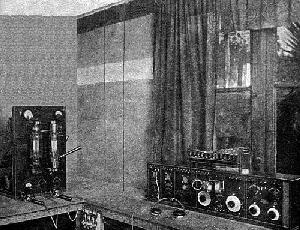 KZY's facilities were quite elaborate, by 1921 standards. The radio room, which
housed the DeForest transmitter and a receiver, opened onto a large music room
where concerts of large groups could be held.
KZY's facilities were quite elaborate, by 1921 standards. The radio room, which
housed the DeForest transmitter and a receiver, opened onto a large music room
where concerts of large groups could be held.
KZY, the Rock Ridge Station, became one of the best-known coastal stations of the period. It had a large and loyal following in the Bay Area, and could be received clearly at night across all of the Western states. Live and recorded music programs were supplemented by news reports supplied by the "San Francisco Call" and the "Oakland Post-Enquirer".
On March 24, 1922, KZY made national history when the station's receiver picked up broadcasts from WGY, Schenectady, New York, marking the first time radio signals had been transmitted across the continent.
The Rock Ridge station's programs continued for only about a year before the company lost interest in maintaining the station and it ceased operation. The City Council of Oakland considered the possibilities of obtaining the station and establishing an Oakland "municipal station". They had hoped to establish it as a publicity agent for the city, as well as to broadcast descriptions of criminals at large to police departments of other cities. But, the concept apparently never took hold, and KZY passed quietly into oblivion after a brief but colorful history.
6XG/KDN
Perhaps the most popular early Bay Area station was 6XG, later KDN, operated
by the Leo J. Meyberg Company, a wholesale electrical firm. KDN was one of a
long series of stations to broadcast from the Fairmont Hotel, atop San
Francisco's Nob Hill, which had always been considered a prime radio site due to
its height. The first Nob Hill station had been an experimental telephone
transmitter operated by the Dewire Wireless Telegraph Company about 1910. This
station, and another in the Fruitvale District of Oakland, were the two
experimental radiotelephone stations of the short-lived company. Another
Fairmont station was operated by the National Wireless Telephone and Telegraph
Company, and operated by San Jose experimenter Doc Herrold. It coincidentally
had the same call letters as the later Meyberg station, 6XG.
The Meyberg operation was established by Sheldon Peterson, Manager of the company, and Gerald M. Best, a phone company engineer. It was situated in a small wooden shack on the roof of the Hotel, right next to the time ball that was used to signal ships. Equipment consisted of a home-brew five- watt transmitter, a Victor phonograph for music programs, and a player piano. A flat-top antenna was strung between two fifty-foot poles on the roof.
6XG went on the air in June, 1921. It was first operated by the Meyberg staff, but this soon became difficult, and the company hired a young radio operator who had just returned from sea. His name was Alan Cormack, later to be Chief Engineer of KFRC and KCBS. Cormack recalled his task was to go to the Sherman-Clay music store daily and pick out records for the programs that evening. These would be borrowed from Sherman-Clay in exchange for mentioning the store as the source of the music. After selecting his records, he would go to the Meyberg offices on Market Street where he would pick up the weather and market reports, "mostly butter and egg prices". He would then go to the station and put the program on the air.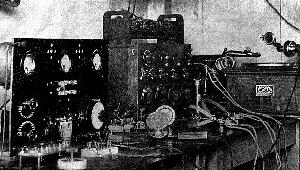 All
programs went on the air through the single telephone-style carbon microphone
connected to the transmitter. Besides announcing into the microphone, Cormack
would hold it up to the phonograph to pick up records, winding it occasionally
to keep the music up to speed. Or, he related, "I used to hang the
microphone at the back of the piano, put on a roll, and sit down and pump
it." Programs of this nature were on the air between one and two hours
daily.
All
programs went on the air through the single telephone-style carbon microphone
connected to the transmitter. Besides announcing into the microphone, Cormack
would hold it up to the phonograph to pick up records, winding it occasionally
to keep the music up to speed. Or, he related, "I used to hang the
microphone at the back of the piano, put on a roll, and sit down and pump
it." Programs of this nature were on the air between one and two hours
daily.
After a while, the station began receiving calls from listeners requesting different types of programs, and KDN started branching out. Some notable special programs broadcast on KDN include a broadcast by a quartet from the Scotti Grand Opera Company, September 29, 1921. This group was staying in the Hotel, and accepted an invitation to sing over KDN. Cormack led them up the tiny wooden stairs to the roof, where they sang into a microphone rigged to the end of a phonograph horn. Madame Ernestine Schumann-Heink, an internationally-known opera singer of the time, also sang over the KDN microphone one evening. Cormack recalled that she was "big, hefty, very German, and very emotional. She was pretty much overcome that her voice was going over the air, to the point where she shed quite a few tears."
Another incident Cormack recalled is the night a small orchestra played for the KDN microphone. There wasn’t enough room in the operator's shack for the orchestra, so they stationed themselves on the roof while Cormack positioned his microphone in the doorway. Just as the broadcast got under way, it began to rain. But, the show must go on, and the little group played its entire concert in the downpour, although, as he recalled, the violins sounded a bit "soggy" towards the end.
At one point in the station's history, Mayor James Rolph and several officials of the Matson Line visited the station. A new luxury cruise ship was beginning its maiden voyage that date, and the men's' speeches were picked up by the ship and piped to the passengers through the P. A. system.In later years, KDN broadcast regular programs of Rudy Seiger's Fairmont Orchestra through a line that had been installed down to the hotel's ballroom for remote pick-ups. In February of 1922, the station built a 50 watt transmitter, and the old five-watter was relegated to standby use. However, the station was still mainly a vehicle for phonograph records and news reports.
Several things finally brought about the demise of KDN. The first was the death of Sheldon Peterson, the driving force behind the station. Mr. Meyberg, the company President, was an older gentleman whose primary interest was in the sale of lighting fixtures and associated electrical equipment. He had little real interest in the station, and lost the desire to operate it after Peterson's death. In addition, a new station, KPO, had installed a remote amplifier to pick up the orchestra programs from the Fairmont, and KPO's 500 watts would provide reception of the Rudy Seiger broadcasts over a larger area than KDN could provide. So, KDN quietly left the air in early 1923.
SOME OTHER EARLY STATIONS
Several other smaller stations were providing radio programs to the Bay Area
audience intermittently during these same years. There was KJJ, operated by Tom
Lambert and A. E. Besse from the Radio Shop in Sunnyvale (who manufactured and
sold their own brand of crystal radio receivers). KJJ was operated from 1921
until an illness in the family forced the closing of the shop and the station in
1923.
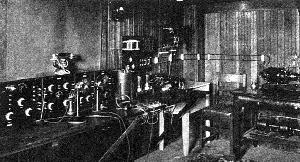 KLP,
known earlier as 6XAC, was operated in 1921 and 1922 by the Colin B. Kennedy
Company, manufacturer of the well- known Kennedy line of receivers. The station
itself was located in the home of Emile A. Portal, the Treasurer of the company,
in Los Altos. Portal was a radio experimenter of many years' experience, having
been one of Doc Herrold's foremost students in San Jose in 1912. Originally,
6XAC was meant to be strictly an experimental station used in connection with
the tests of Kennedy receivers. However, response to the unscheduled programs
resulted in the company obtaining the KLP license for commercial broadcasts.
Portal sent out weekly post cards to listeners that gave the program schedule
for that week. Programs consisted entirely of phonograph records.
KLP,
known earlier as 6XAC, was operated in 1921 and 1922 by the Colin B. Kennedy
Company, manufacturer of the well- known Kennedy line of receivers. The station
itself was located in the home of Emile A. Portal, the Treasurer of the company,
in Los Altos. Portal was a radio experimenter of many years' experience, having
been one of Doc Herrold's foremost students in San Jose in 1912. Originally,
6XAC was meant to be strictly an experimental station used in connection with
the tests of Kennedy receivers. However, response to the unscheduled programs
resulted in the company obtaining the KLP license for commercial broadcasts.
Portal sent out weekly post cards to listeners that gave the program schedule
for that week. Programs consisted entirely of phonograph records.
Years before there was ever a KSL in Salt Lake City, those call letters were assigned to a station operated by the Emporium Department Store in San Francisco. The operating room was on the seventh floor, where there was also a studio large enough to hold a small orchestra. The station was operated by Harold R. Shaw, a former KDN engineer, along with Harrison Holliway (who would later start KFRC). KSL went on the air on April 3, 1922, but lasted only a year.
KUO
Two days before KSL went on the air, the "San Francisco Examiner" began operation of its own powerful station, KUO. The Hearst newspaper had installed the studio and transmitter in a building constructed on the roof of the Hearst Building, at Third and Market Streets. The station went on the air April 1 at 5:30 PM with all the glamour and pageantry the Examiner's radio editors could muster. The dedicatory program is an excellent example of what radio sounded like in its infancy:
(Operator Charles A. "Sparks" Gaal speaking:) Hello, hello, hello. This is KUO ... K - U - O ... the San Francisco Examiner broadcasting station, calling. Greetings. The Examiner extends its greetings to all of you far and wide. By the means of this high-powered radio station, the Examiner proposes to serve you daily with news bulletins, music, weather and crop reports, and other data of interest. Because of the opportunity of rendering further public service, the Examiner has constructed this big radio station. To you fifty thousand persons now sitting in on the ether wave, the Examiner sends its greetings.This was followed by an opening address by Mayor Rolph, a few numbers performed by Herb Meyerinck's St. Francis Hotel Orchestra gathered around the studio mike, and several phonograph records. The program ended at 6:45.
KUO's studios were officially completed the following month. They consisted of a large "acoustically-perfect" studio with the transmitting equipment sitting in one corner, and a special battery room. The antenna stood 150 feet above the twelve-story building. The KUO transmitter, nicknamed "Big Bertha", was the most powerful in the area at the time, rivaling only KLX in Oakland for signal strength.
"Sparks" Gaal was the operator and sole member of the KUO staff during its entire existence. The station began with a full head of steam, but like many others, began to lose interest after about a year. By 1924, it was broadcasting programs on an irregular basis, consisting largely of weather and farm reports, news, sports and stock quotations. The Examiner began to quietly phase out its broadcast operations, and by September, 1924, had taken the KUO schedule off its own radio page. However, KUO continued to operate until 1927, sending mainly weather and marine information to the San Francisco pilot boat.
KFDB
In 1922, the a bank called the Mercantile Trust Company (later absorbed by
merger into the Wells Fargo Bank) decided it would become the first bank in the
world to operate a radio station. It planned to open a high-powered station that
would cover all of Western America and, through the bank's exposure to the rural
West via this station, expand its territory and open a number of rural branches.
Its frequent broadcasts of market and weather reports would attract a large farm
audience by informing farmers of the latest prices on the San Francisco market. 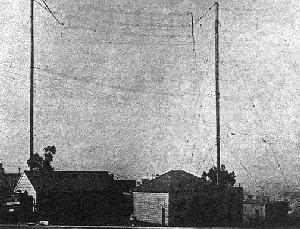 KFDB began construction in May of 1922 near the summit of Telegraph Hill, where
Lombard Street turns and begins its ascent toward Coit Tower. The bank
constructed three separate buildings for the station: a concrete transmitter
house and wood-frame studio and artists buildings. A fifty- watt transmitter was
constructed by Chief Engineer Ralph Heintz and his assistants, and a separate
linear amplifier was built to boost the output to a maximum power of 1,500
Watts. This was one of the first times a linear amplifier was used by any
station. Underneath the floor of the transmitter building was a battery room
containing over 300 six-Volt batteries, all connected in series to provide the
necessary 2,000 Volts plate voltage for the transmitter. Motor generators were
used in turn to charge the batteries. The KFDB antenna system was suspended
between two hundred-foot spruce poles that had been floated down from the
Northwest on a log raft. It consisted of three fourteen-inch "cage"
elements, with a ground element suspended below it that could be raised or
lowered for best effectiveness. A system of counterpoise wires was arranged in a
fan-like pattern, stretching from the roof of the transmitter building.
KFDB began construction in May of 1922 near the summit of Telegraph Hill, where
Lombard Street turns and begins its ascent toward Coit Tower. The bank
constructed three separate buildings for the station: a concrete transmitter
house and wood-frame studio and artists buildings. A fifty- watt transmitter was
constructed by Chief Engineer Ralph Heintz and his assistants, and a separate
linear amplifier was built to boost the output to a maximum power of 1,500
Watts. This was one of the first times a linear amplifier was used by any
station. Underneath the floor of the transmitter building was a battery room
containing over 300 six-Volt batteries, all connected in series to provide the
necessary 2,000 Volts plate voltage for the transmitter. Motor generators were
used in turn to charge the batteries. The KFDB antenna system was suspended
between two hundred-foot spruce poles that had been floated down from the
Northwest on a log raft. It consisted of three fourteen-inch "cage"
elements, with a ground element suspended below it that could be raised or
lowered for best effectiveness. A system of counterpoise wires was arranged in a
fan-like pattern, stretching from the roof of the transmitter building.
The studio was an 18-by-24 foot building, acoustically draped and decorated with wicker furniture, a piano and a phonograph. The microphone was mounted on a flower vase pedestal and covered with a drapery arrangement to hide it from the view of nervous performers. The entire apparatus was affectionately called "Julius" by the staff.
KFDB began operation on an experimental basis in August under the call letters 6XB. During this period, the fifty-watt transmitter was used late at night to test the equipment for sound quality and coverage. The staff was quickly pleased with the results of the test: on the night of October 28, their tests were answered by CFCN in Calgary, Alberta, and were picked up by listeners several hundred miles north of there. On November 2, they were heard clearly by several receivers in Hawaii.
Finally, KFDB began broadcasting on a regular schedule November 1. During the daytime, programming was devoted to agricultural news and market reports, with hour-long reports broadcast at 10 AM and 2 PM. These were transmitted on 360 meters, the only frequency allocated by the government for broadcasting at that time and which was shared by all stations. However, the government had also authorized a limited number of stations to broadcast agricultural information on a separate frequency, 485 meters. KFDB held this license in the Bay Area, and at 6:30 PM daily it broadcast market information which it received via Morse code from a Department of Agriculture station.
In addition to all of its farm programs, KFDB broadcast a daily concert from 9 to 10 PM. This was arranged for the station by the Pacific Radio Trade Association, which was an organization of radio retail merchants and broadcasters that acted as the governing board of Bay Area radio. (The P. R. T. A. also managed the time schedules for the area stations sharing 360 meters and operated a yearly radio exposition in San Francisco.) The KFDB programs were a direct result of comments that were made by some of the smaller stations at a P. R. T. A. meeting. They complained they could not endure the heavy expense of operating a station, and that the P. R. T. A. should pool its efforts and produce a single high-powered station with first-class programs, instead of just coordinating the activities of several mediocre stations. KFDB offered time over its new station to test this method of joint programming, and President Arthur Halloran agreed to put it on an initial one-month test.
KFDB's concert hour commenced November 1, 1922. This program was referred to as a "community broadcast center" and was entirely programmed by the P. R. T. A. under the direction of Mrs. Ada Morgan O'Brien (who would later manage the programming for KPO and KTAB). The best musical talent in the Bay Area was hired to perform on this daily program, and Mrs. O'Brien personally escorted the performers to the station by limousine! No expense was spared to make these broadcasts the very best. Public reaction to the concert hour was very favorable, and, although the proposed P. R. T. A. station never materialized, the program was extended well beyond its initial test period.
Despite KFDB's high standards of operation, the station soon followed the route of so many of its predecessors and soon ceased broadcasting. There were several factors that eventually led to its demise. First of all, the station did not enjoy the coverage its owners had hoped for. Although it could be received over most of the Western States as hoped, reception was sporadic and the truly dependable coverage area was much smaller. Although KFDB had regular listeners in the San Joaquin valley and a few branches of the bank were opened there, it was not the publicity and expansion agent they had hoped for.
Secondly, equipment failures were frequently. The fault lay, not in the station's construction or operation, but in its basic concept of design. The state of the art in electronics had simply not advanced enough to perfect the linear amplification system used by KFDB. As a result, the transmitter broke down on the station's opening broadcast, and it was quite a regular occurrence for it to be off the air due to equipment failure. Eventually, the bank decided that, because of these problems, the high cost of operating the station did not justify the few publicity benefits that were reaped. They finally shut the station down on November 30, 1923. KFDB, the great innovator and one of the most elaborate stations of its era, had lasted hardly more than a year.
MORE EARLY STATIONS
By the end of 1923, radio had swept the country and become a firmly- entrenched entertainment medium. However, without any means of generating an income, stations continued to go on and off the air in relative quick succession. For example, there was KFCM, operated by the Richmond Radio Shop in Richmond. It was on the air only one day a week for nine months during 1923. KQI, an educational station operated by the University of California in Berkeley, hadn’t been on the air a month before it folded for some long-forgotten reason. And, there were many other licensed stations that never even made it on the air. Some of these in the Bay Area were KFGH, licensed to Leland Stanford Junior University in Palo Alto; KDZG, Cyrus Pierce and Company, San Francisco; KDZW, Claude W. Gerdes, San Francisco; KDYN, Great Western Radio Corporation, Redwood City, and a station licensed to the Radio Shop in San Jose. Another planned station operated by the City of San Jose. The City Council authorized the station in 1922, and announced the needed $6,000 would be raised by subscription. Most likely, not enough people were interested in donating to the cause to enable the station to become airborne.The selection of stations on the radio dial in San Francisco stayed relatively stable during 1924, but 1925 saw the onslaught of a second "wave" of new stations nationwide, almost as great as 1922. In the Bay Area, seven new stations took to the airwaves within a ten month period, and only three of them lasted more than a few years.
At that time, unless an applicant requested specific call letters, they were chosen for the applicant by the government, and assigned in alphabetical order. For this reason, many of the stations had similar call letters, which must have caused considerable confusion among the listeners.
KFUS
A new station began broadcasting from Oakland on March 9, 1925. KFUS was operated by Dr. Louis L. Sherman, who practiced medicine and gave lectures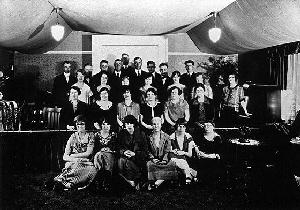 from his home at 28th Street and Telegraph, where the station was also located.
Dr. Sherman had been answering medical questions from listeners on a KLX program
for several years, and this led him to start his own station, which was also
used to broadcast his classroom lectures. The station consisted of a fifty Watt
Western Electric transmitter, a control room, a small studio and Dr. Sherman's
classroom. Preston Allen and his KLX staff constructed the station for Dr.
Sherman, and they also supplied the announcers and technicians to run it.
from his home at 28th Street and Telegraph, where the station was also located.
Dr. Sherman had been answering medical questions from listeners on a KLX program
for several years, and this led him to start his own station, which was also
used to broadcast his classroom lectures. The station consisted of a fifty Watt
Western Electric transmitter, a control room, a small studio and Dr. Sherman's
classroom. Preston Allen and his KLX staff constructed the station for Dr.
Sherman, and they also supplied the announcers and technicians to run it.
KFUS relied heavily on religious programming. Dr. Sherman gave free time to many of the churches in the area without regard to denomination. In fact, he built a small church himself just a year later, and his son became the pastor. It was located on Havenscourt Road near E. 14th Street, and the station was moved there in 1926. The antenna was strung over the church, between two metal towers. One of these towers was still standing in the 1970's. It was at the Havenscourt Community Church, the successor to Dr. Sherman's church. The tower held the letters "Jesus Saves".
The station's license was revoked by the Federal Radio Commission in 1928, on the grounds that it had often drifted too far from its frequency and had not been on the air often enough to warrant the additional congestion of the airwaves. However, in its short history it was notable as having been the first radio station to carry the voices of Luther Burbank and Earl Warren (then Deputy District Attorney of Alameda County - later U.S. Supreme Court Chief Justice).
NEW STATIONS OF 1925
Another short-lived station was KFUU, which went on the air March 29, 1925, operated by the Colburn Radio Laboratories in San Leandro. After only six months of operation, the license was transferred to Matthewson Motors at 3024 Broadway in Oakland. It broadcast recorded music three days a week for only a few hours a day, and by the following July its license had been voluntarily surrendered.Then there was KFQH, which was licensed to San Mateo Union High School, but located at the Radio Service Company, a Burlingame radio shop. The license was later acquired by the Burlingame Chamber of Commerce, which changed the call letters to KFOB. It too bit the dust after just over a year of operation.
1925 was a good year for church stations. KFWM went on the air October 15, operated by the Educational Society of Oakland, also known as the Watchtower Society or Jehovah's Witness, and headquartered in a church on Eighth Avenue in East Oakland. The transmitter and studio were located in a separate building on the church property, and the antenna was strung between two wooden poles. The station shared its frequency with another new church station, KGTT, which was operated by the Glad Tidings Temple on Ellis Street. KGTT debuted November 30 with 50 Watts, and was operated by the Pastor, Robert J. Craig, who was also the Station Manager and announcer. By 1930, KFWM had become KROW and KGTT had been sold to the Golden Gate Church and became known as KGGC. Both stations are still on the air today.
The last new station to make its debut in the San Francisco market went on the air January 22, 1926, and was the only one among these late-comers that attempted to air any high caliber radio entertainment. The company called itself Radio Entertainments, Inc., and it was licensed as KFWI. Thomas Catton, one of the original founders of KFRC, was the Manager of the station and he continued a program called "The Tom Cats" which he had originated on KFRC. The studios were in the Wiley B. Allen building on Van Ness Avenue, with the 500 Watt transmitter atop Twin Peaks. KFWI broadcast on a frequency of 1200 kHz (later 1120).
KFWI started out with great plans and made a serious attempt at becoming a first class station, operating with a large and varied program schedule. But it seems to have been beset from the start by internal turmoil. Catton resigned the following year, along with Vice President Ernest Walcott. KFWI went through several more managers in the next few years. Studios were moved to the Marshall Square Building at Eighth and Market in 1927, and later to the Bellevue and Pickwick Hotels. In the latter location, it occupied studios built for KTAB that had been vacated after the stock market crashed forced that station's ownership into bankruptcy. A Federal Radio Commission reassignment of frequencies in 1928 had forced KFWI to share time on 930 kHz. with KFWM in Oakland, which limited the station's potential. Further, like many, the station suffered financial setbacks in the depression. It was able to struggle for a few more years before running out of money. By 1933, KFWI was off the air.
FEDERAL RADIO COMMISSION TO THE RESCUE
The radio congestion problem had reached major proportions in San Francisco by the mid twenties, as it had around the country. The courts had ruled that the Department of Commerce did not have the authority to say "no" to a prospective applicant for a radio license, or to exercise any control over the station once it was on the air, and this had turned the radio spectrum into a free-for-all. This mess was further complicated by the fact that stations were changing their frequencies without authorization so they could be better heard. KQW, KTAB and KFWM were all said to be guilty of this in the Bay Area, taking advantage of the government's lack of control over broadcasting. In addition, KYA became the first station in the area to break what had become a local broadcasting tradition: the “DX period”. This was a half hour of silence observed simultaneously by all area stations every day, so that radio buffs could tune for distant stations. When KYA broke the silence, others quickly followed, to the chagrin of many radio enthusiasts.Just as radio was about to be rendered totally useless in all of the confusion, the Federal Radio Commission was organized. This was an independent government agency that had been given the authority to effectively regulate broadcasting. It quickly took charge and immediately made sweeping changes. The frequencies of 129 stations were re-assigned on Nov. 11, 1928, and it was made known that any deviation from these frequencies would result in a loss of license. The F.R.C. also gave notice to 164 stations that they were not judged to be serving in the public interest, and that their licenses had been suspended pending hearing. Most of these notices were received by stations in the East and Midwest, where the greatest congestion problems were being felt. Only five stations on the West Coast were notified, and none of them was in the Bay Area. In the end, 109 stations were forced off the air by this notice.
The coming of the Federal Radio Commission in 1927 marked the official end of radio's "childhood". It had sewn the last of its wild oats, and had finally become a mature mass medium. Within a few years, the last of the little "shoestring" stations in the Bay Area would be gone, and only twelve stations would remain on the dial: KQW, KFRC, KTAB, KGO, KPO, KLS, KLX, KRE, KYA, KROW, KJBS, and KGGC. These were the only stations heard in San Francisco from 1933 until the end of World War II, and all of these remain on the air to this day. The future for radio lay in the big broadcast networks, and radio was finally settling down to the task of becoming the greatest entertainment medium in the nation.
REFERENCES:
6UV/KYY: "Pacific Radio News", October, 1921. 6XW/AG1: "Radio" Magazine, November, 1921. 6XC/KZY: "Father of Radio", by Lee DeForest. "Pacific Radio News", July 1920. "Radio Magazine", February, 1922. "San Francisco Chronicle", March 24, 1922. 6XG/KDN: Interview between author and Alan Cormack, former KDN operator, San Anselmo, California, December 1, 1970. "Pacific Radio News", July, 1921. "San Francisco Chronicle", March 22, 1922. KUO: "San Francisco Examiner", March 25, 1922. "San Francisco Examiner", April 2, 1922. "San Francisco Examiner", May 2, 1922. Interview between author and Bruce Lathrup and Vic Paulsen, San Francisco radio engineers, who remembered hearing this station. San Francisco, California California, December 9, 1970. KFDB: Interview between the author and Harry Wickersham, former KFDB operator, San Mateo, California, March 16, 1971. "Radio" Magazine, December, 1922. "Monthly Review", November 1922. Published by the Mercantile Trust Co. "Oakland Tribune", October 31, 1922. Other Stations: Interview between author and Dr. Louis L. Sherman, former owner and operator of KFUS, Oakland, California, October 29, 1970.
© Copyright 1997 John F. Schneider. All rights reserved.
For better views of the photographs, see the Photo Archives section of this website.
[Go to Index of Articles] [Go to Photo Archives] [Return to Home Page]